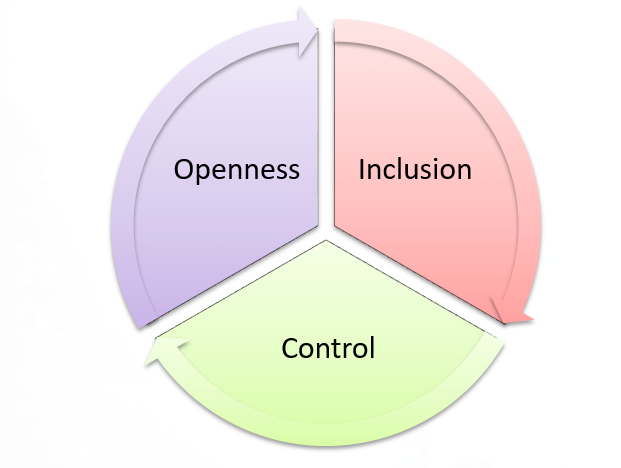Humanizing Virtual Teams
Virtual team management has always been difficult for managers. Still, the COVID-19 epidemic and the shift of many workers to working from home resulted in a dramatic growth in virtual teams worldwide. As much as leading and maintaining virtual teams is challenging yet, there are some solid basic human needs that leaders need to make sure of as they approach their teams to build trust, create a culture of autonomy, and ensure inclusion among a virtual team.
The three solid basic human needs are derived from The Human Element (THE).
The Human Element is based on FIRO theory. It identifies three basic needs that all human beings share; the need to feel significant, competent, and likable. When people interact with each other, they seek the right amount of inclusion, control, and openness so that they can feel good about themselves. How does the basic needs all human beings share can be utilized in building trust amount the virtual team?

Principle 1: Openness
According to The Human Element, the definition of "Openness" is:
"Openness is the depth of interaction with other people. Expressing feeling, thoughts, and beliefs". Hence, according to this definition, Openness among a virtual team is much needed to build trust. If team members are unable to express their thoughts and feelings, then there is a lack of trust.
The question now, how can we build trust in Virtual teams?1
Provide opportunities for people to form bonds.
Over time, team members gain trust in one another. If and when practicable, scheduling face-to-face meetings for the team helps members create relationships and better understand the scope of their job, team makeup, timetables, communication methods, and decision-making structure. New virtual teams should meet in person at least once within the first few months and on a more regular basis if possible in the future.
Provide opportunities for team members to network and exchange their skills.
Providing opportunities for team members to present on a topic where they know, such as monthly lunch and learn events, can boost individuals' credibility and make others more likely to contact them when they need help. These discussions do not have to be about business. When a team organized an online session where members are welcomed to discuss their "unknown skill", there might be a surprise in knowing the unknown skills and interests of other team members that cause the opportunity to build new connections.
Use Technology to facilitate communication.
Technology-enabled communication has become a fundamental component of project development in virtual teams. However, because this communication differs from that found in an office, actions must be taken to ensure that teams build efficient communication techniques to reach optimal performance. In technology implementation, two frequent mistakes might undermine team effectiveness. These problems are usually caused by 1.) team members' lack of experience with the communication software in use (e.g., video conferencing, instant messaging) and 2.) technology that isn't properly matched to the circumstance. To create a successful workplace, careful planning and awareness of the benefits and downsides of various communication media are required to optimize trust-building and enhance interactions among team members.
Principle 2: Control
According to The Human Element, control behavior relates to the decision-making process between people and the areas of power, influence, and authority.
How can we create a culture of autonomy and achievement among virtual teams?
According to a report published in 2020 by Harvard Business Review, 38% of managers polled feel that remote workers perform worse than those who work in an office, with another 22% undecided. That's a whopping 60% of supervisors that are concerned about their remote workers' performance. When it comes to managing remote teams, visibility of work is a significant challenge. Micromanagement, on the other hand, isn't the solution.
It might be challenging to strike a balance between the requirement for visibility and the need for autonomy. So, what can managers do to ensure that virtual and hybrid teams are more empowered, happy, and productive?
Challenge Mindset.
Leaders and managers need to challenge and beliefs regarding employees. Managers who believe that work is a burden and that people go to work because they have to rather than because they want to are more prone to apply an authoritarian motivating style. This approach is founded on the idea that to perform well; people require extrinsic incentives — without focused attention and clear rewards, people are likely to become less productive. These ideas can become more obvious while managing virtual or hybrid teams. A manager with little trust in their staff may no longer stroll through the office and gently (or not-so-subtly) check on them; instead, they must email, message, or call, which can appear more deliberate, blatant, and invasive. Such a managerial style can soon devolve into micromanagement, resulting in an unhappy and unproductive workforce.
Communicate as much as possible.
It's critical to communicate your intentions regarding workplace autonomy. Expectations about working styles are not always as evident in a virtual setting as in a physical office, and previously unspoken limits may need to be clarified.
Decide what sorts and levels of autonomy you can provide, then discuss it with your staff.
Encourage them to think of this as a continuous conversation and consider how you can make changes as their needs evolve. Though it may not always be possible to provide complete autonomy in all areas, it's critical to discover strategies to assist your staff tap into their inherent drives and feel empowered to manage their workday. 2
Principle 3: Inclusion
According to The Human Element, inclusion behavior refers to people coming together, being excluded or included, belonging, and togetherness.
How can you ensure inclusion among a virtual team?3
Make people feel like they're a part of something.
Humans have an innate desire to belong to a group, which is why leaders must do everything they can to foster a sense of belonging, teamwork, and connection in this new era of remote work. Still, hosting another Zoom meeting isn't going to do anything to boost participation or support the company's culture. There are other possibilities.
A virtual reality workplace is one such solution since it allows remote team members to meet in a virtual world and use individualized avatars to express their unique personalities. They can comfortably connect with coworkers in real-time in a virtual place of their choices, such as an office or a park. Allowing a couple of team members to work on a project together over a video conference can also be beneficial, as it keeps them focused on the same goal and allows them to motivate one another.
Demonstrate empathy.
Belonging—the need to believe that one's boss and coworkers are concerned about one another—is an essential part of inclusiveness and engagement. In a conventional work environment, managers and employees display concern through in-person social contacts. Demonstrating caring in a remote work environment, on the other hand, is significantly more difficult. Team leaders should take advantage of the chance to exchange personal information, get to know team members on a more personal level, and set out time each week to check in on how individuals are physically and emotionally. They must inquire about people's needs, acknowledge them, and modify their activities to meet those requirements.
Encourage people to participate.
Exclusionary dynamics within teams have the potential to be reinforced in a distant setting without targeted intervention. It is recommended that team leaders establish direct communication with employees, make an effort to include them in team discussions, and ensure that all team members have an equal opportunity to contribute in virtual meetings. Managers must also be aware of the various communication styles used by their employees. People may be having difficulty joining the discourse because their communication style is unorthodox rather than unsuccessful.
Leaders and their remote staff need to acknowledge their challenges.
Together, they need to explore new methods to work better and smarter. Employees should be encouraged to offer ideas they believe will help them collaborate more effectively, be more creative, or be less stressed. Not only will this keep workers engaged as their working lives evolve, but it will also pay off in terms of more flexible, resilient, innovative, and empowered teams now and in the future.
1LinkedIn, 23 Mar 2021, Jim Citrin, 6 Tips to Building trust on virtual teams, Accessed 29 Jan 2022, https://www.linkedin.com/pulse/6-tips-building-trust-virtual-teams-which-here-stay-jim-citrin/
SHRM, 2018, Jared Farrell and Kelsey Kline, Facilitating Trust and Communication in Virtual teams, Accessed 29 Jan 2022, https://www.shrm.org/executive/resources/people-strategy-journal/Spring2018/Pages/trust-communication.aspx>
2The Virtual Training Team, 30 Jul 2021, Grace Woods, Managing Autonomy in Virtual and Hybrid Teams, Accessed 30 Jan 2022, https://www.thevirtualtrainingteam.com/blog/managing-autonomy-virtual-teams
3Forbes, 9 Dec 2020, Alex Howland, How leaders can keep culture intact in a virtual workplace, Accessed 29 Jan 2022, < https://www.forbes.com/sites/forbestechcouncil/2020/12/09/how-leaders-can-keep-culture-intact-in-a-virtual-workplace/?sh=35b8026c7637>
SHRM, 26 Aug 2020, Roy Maurer, 6 Ways to Foster Inclusion Among Remote Workers, Accessed 29 Jan 2022, https://www.shrm.org/hr-today/news/hr-news/pages/6-ways-foster-inclusion-among-remote-workers.aspx
For more about this topic, download our latest book " The Different Dimensions of The Virtual Workplace " for FREE:
